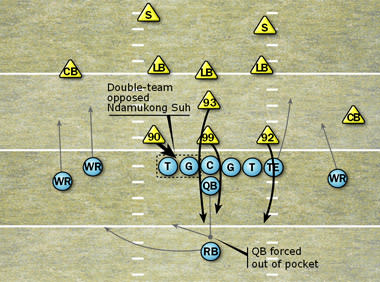Suh, Fairley give Detroit's 'D' options galore
Editor's note: Yahoo! Sports will break down how 12 top 2011 NFL draft picks can immediately impact their new clubs.

Auburn's defensive tackle Nick Fairley(notes) celebrates against Oregon in the BCS championship game on Jan. 10, 2011.
(Getty Images)
Just two years after the 0-16 nightmare created by the historically inept Matt Millen, the 2010 Detroit Lions managed to become a very dangerous team under the leadership of new general manager Martin Mayhew and head coach Jim Schwartz. Two solid drafts had helped overcome the personnel mismanagement of the prior regime, and the 2010 first-round selection of Nebraska defensive tackle Ndamukong Suh(notes) paid enormous dividends when his dominant season ended with a Defensive Rookie of the Year nod.
Detroit made some noise in the NFC North in 2010, but the team's 6-10 record was due in part to a secondary that couldn't consistently stop anybody, even with the help given by a dominant front. So, when the Lions chose Auburn defensive tackle Nick Fairley with the 13th overall pick despite there being two potentially dominant cornerbacks (Nebraska's Prince Amukamara(notes) and Colorado's Jimmy Smith(notes)) still on the board, it raised some eyebrows. Especially since Suh and Fairley are similar players in many ways – constantly looking to split gaps and disrupt quarterbacks, and with surprising turn-and-run speed as opposed to the "big fatties" who stop up blockers and don't rack up stats. Do the Lions have too much of a good thing?
Some may wonder what they will do with two players best suited for pursuit in the same line at the same time, but Schwartz and Cunningham recognized that they could do all kinds of things with Fairley and Suh. The standard idea in a four-man front would be to put one just off the center in a one-tech look and the other between guard and tackle in a three-tech position. Or, they could line up both tackles head over the guards, forcing the center to pick a side and be wrong either way.
One of the more interesting things the Lions did with their four-man fronts last season was putting a defensive end back in more of a three-man-front look between the nose tackle and the middle linebacker, generally occupying a gap in a flex position.

Early in a Week 8 win over the Washington Redskins, the Lions used this setup to pressure the quarterback and force an incompletion on a short pass from Donovan McNabb(notes) to Ryan Torain(notes). The real difficulty in stopping the scheme was the "who to block?" dilemma when defensive tackle Corey Williams(notes) (99) twisted to his right out of the one-tech spot and flex end Kyle Vanden Bosch(notes) (93) stunted through the gap Williams vacated.
At the same time, the inevitable double-team opposing offenses had to dedicate to Suh (90) took the Redskins' left guard and left tackle away from any ability to help. Williams and Vanden Bosch crashed the pocket, and McNabb just got a throw off in Torain's area before he would have been sacked.
As disruptive as Williams was last season, imagine Fairley in Williams' spot, or even in the other three-man end spot occupied in this case by Cliff Avril(notes) (92). That is the real point and wisdom in taking Fairley when other options were still on the board – the idea of rare versatility on a front in which a coaching staff can deploy its personnel in some very original ways. That's the key to nearly every dominant defense in NFL history, and the Lions now have that capacity as they try to move into the NFL's elite.
The Detroit theory now seems to be: Your quarterback can't hurt our secondary if he's on the ground all the time.
